Secrets in Plain Sight: Symbols and Codes Used in the African Slave Trade"
slave trade

In the murky waters of the African slave trade, where ships sailed with human cargo and fortunes were made from the misery of others, there existed a clandestine world of symbols and codes. These were not your ordinary secret messages scribbled on scraps of parchment, but rather, hidden in plain sight, woven into the very fabric of daily life. So buckle up, because we're about to embark on a journey through the mysterious world of symbols and codes used in the African slave trade.
Imagine yourself strolling through the bustling streets of a coastal port, the air thick with the scent of salt and sweat, as traders hawk their wares and sailors bustle about. Amidst the chaos, there are signs and symbols adorning storefronts and market stalls, innocuous to the untrained eye but pregnant with meaning for those in the know.
Take, for example, the humble pineapple. To the uninitiated, it may seem like nothing more than a tropical fruit, but to those versed in the secret language of the slave trade, it was a symbol of wealth and hospitality. Planters would proudly display pineapples on their gateposts, signaling to passing ships that they were open for business and willing to pay top dollar for human cargo. Little did they know, they were unwittingly broadcasting their complicity in the horrors of the trade for all to see.
But symbols weren't the only tools used to communicate covertly in the world of the African slave trade. Enter the world of codes, where seemingly innocuous phrases and gestures held hidden meanings known only to the initiated. Picture this: a group of enslaved people gathered around a makeshift fire, their faces illuminated by the flickering flames as they engage in hushed conversation. To the casual observer, it may seem like nothing more than idle chatter, but to those in the know, it was a carefully orchestrated exchange of information.
For example, the song "Follow the Drinking Gourd" may sound like nothing more than a catchy tune, but to enslaved people seeking freedom, it was a roadmap to liberation. Hidden within its lyrics were coded instructions for navigating the Underground Railroad, guiding escapees along their perilous journey to freedom. It just goes to show that sometimes, the most powerful messages are hidden in plain sight, waiting to be deciphered by those with the courage to seek them out.
But amidst the darkness and despair of the slave trade, there were moments of levity and humor that served as a respite from the harsh realities of daily life. Picture, if you will, a group of enslaved people gathered together for a secret meeting, their spirits buoyed by the knowledge that they were not alone in their struggle. As they exchanged coded messages and shared stories of resistance, laughter rang out like a beacon of hope in the darkness.
In the end, the symbols and codes used in the African slave trade serve as a reminder that even in the face of unspeakable cruelty and injustice, there is always hope. They are a testament to the resilience of the human spirit, the power of solidarity, and the enduring legacy of those who dared to resist. So let us remember their stories, let us honor their memory, and let us never forget the secrets hidden in plain sight.
About the Creator
Alexander Mensah
With a blend of expertise, creativity, and dedication, my article promises to captivate and entertain. Backed by thorough research and a passion for storytelling, each word is crafted to inform and engage readers. Join the conversation
Enjoyed the story? Support the Creator.
Subscribe for free to receive all their stories in your feed. You could also pledge your support or give them a one-off tip, letting them know you appreciate their work.






Comments
There are no comments for this story
Be the first to respond and start the conversation.